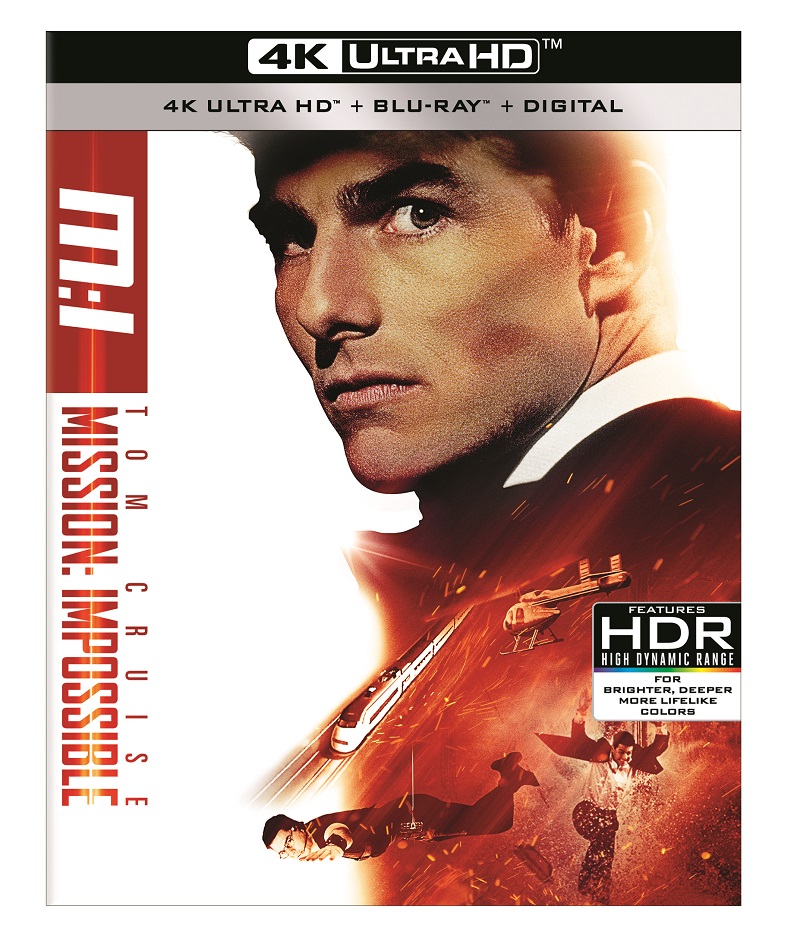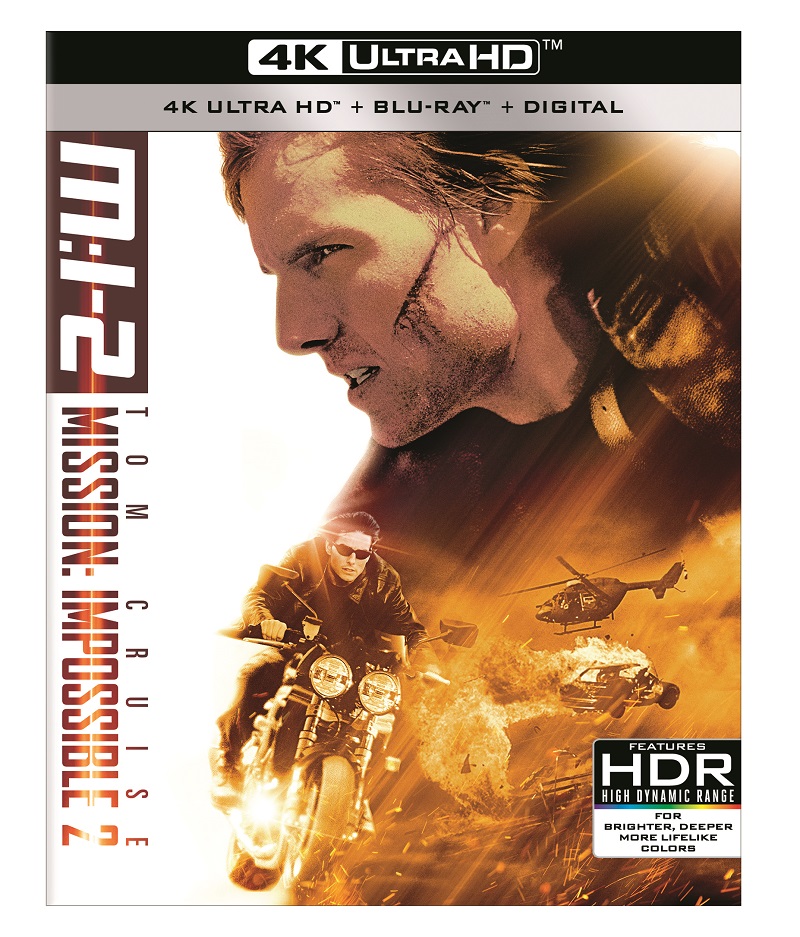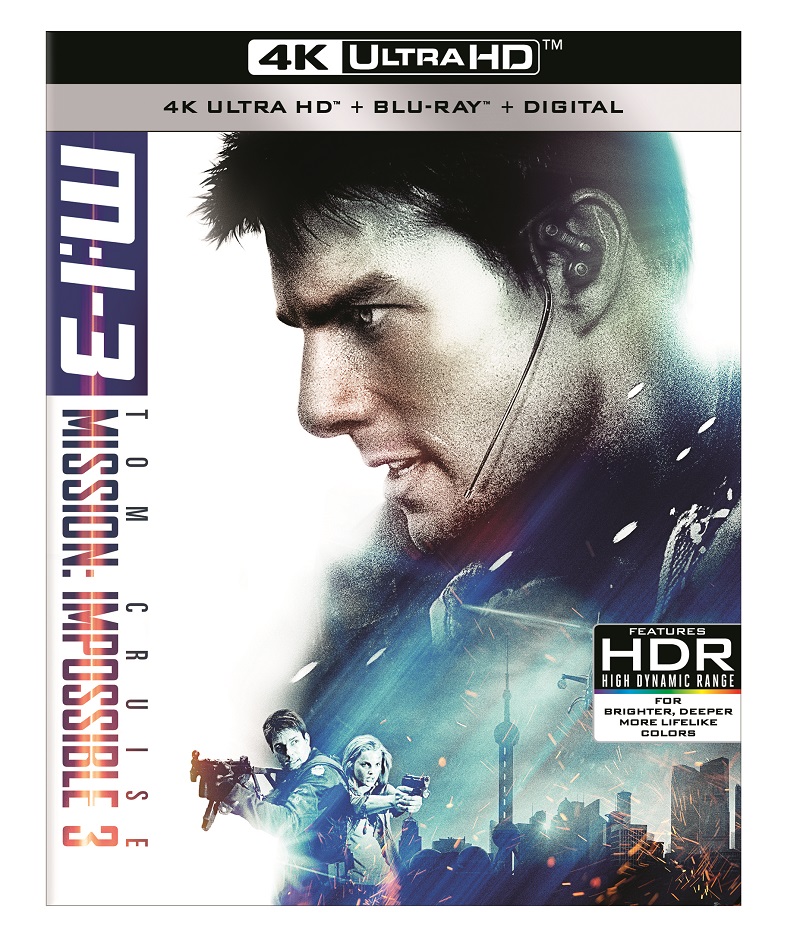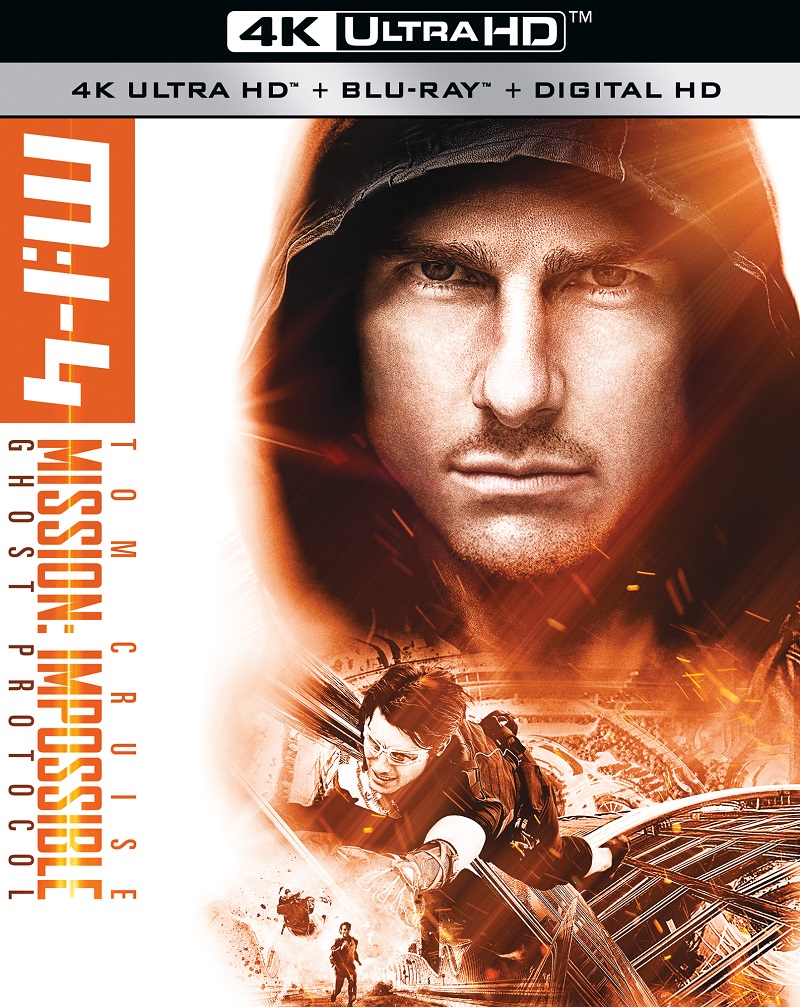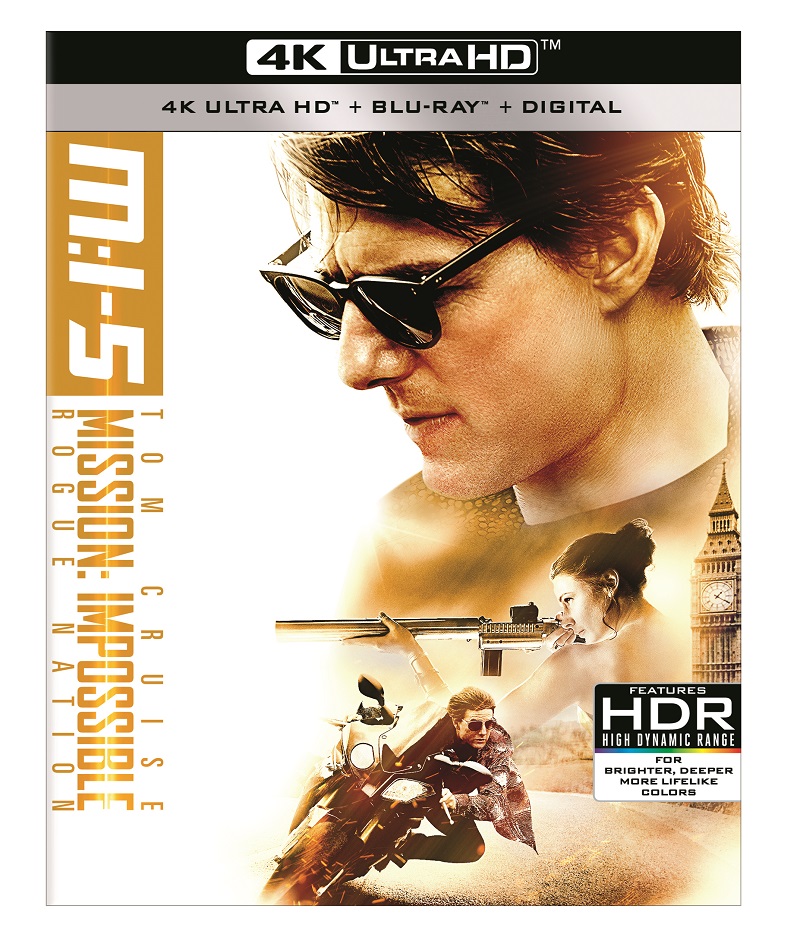When the first Mission Impossible arrived on Blu-Ray in 2007, it was a swing-and-a-miss effort—technically speaking. The picture was flat. The sound was not where it should be for the new-at-the-time home video format. Compared to other films being released on Blu-Ray at the time, Mission failed to bring the luscious look of the movie on the big screen to the home video market.
With Mission Impossible: Fallout on the verge of being released (July 26), Paramount Home Media has gone and righted a wrong… and done one better. Well, four better to be more specific.
Mission Impossible 1 through 5 have landed on a delightful and dazzling 4K Ultra HD upgrade as a five-film set that could not be a more must-own. To date, the Tom Cruise starring series has banked $2.779 billion dollars at the box office. Each certainly has its own fans, but in this writer’s opinion, the fourth and fifth installments are by far the best of the series. That is clearly why anticipation for Fallout is through the roof. But, before we look forward, let’s look back and delve into why each of these are worth the upgrade to a 4K Ultra HD.
The first film, as we stated, is required viewing for all film fans for several reasons. Due to its lackluster transfer to Blu-Ray, upgrading to the 4K is a true no-brainer.
Mission Impossible landed in 1996 and was supposed to be the huge comeback of legendary filmmaker Brian De Palma. It clicked on so many levels. At the time, it was the rare television series to make the leap to the silver screen that was widely regarded as a successful, both financially and critically. There were so many moments in the kick-off flick that have become pop cultural icons. The CIA break-in scene?! The exploding aquarium?! The quote, “you’ve never seen me very upset!” There are movie franchise arrivals and there is the seismic movie industry eruption that was Mission Impossible.
Cruise was in dire need of his own franchise in a town that was truly embracing its inner franchise needs. The superstar got it and frankly could never have expected that 22 years later, he would be prepping to head out on a press tour for his sixth film that bore the moniker Mission Impossible.
When the sequel to Mission Impossible was announced, De Palma was either not asked or did not want to return. Instead, the film was given a fresh flavor with legendary Hong Kong helmer John Woo taking the reins. The 2000 release was divisive. Some loved it and others thought it was a bit airy, artsy and lacked an antagonist that was worthy of Cruise’s star power. Of course, there was a sequence involving doves flying in slow motion—a trademark element of any Woo film. It also worked for this writer because of Woo’s uncanny ability to treat violence and action as if it was ballet.
Its thrilling choreography was breathtaking, even if the story failed to have the brut force weight that the first film had four years prior. That being said, Mission Impossible 2 was still of the upper echelon of action movies for that millennial year and holds a special place in my heart for its artistry in action.
Before Mission Impossible 3, J.J. Abrams was strictly a TV guy and the third Cruise film in the franchise certainly put the auteur on the cinematic map. It would be one of the first times that Abrams would pair with writers Alex Kurtzman (Star Trek) and Roberto Orci (Star Trek: Into Darkness). The result was, a slight step up from the Woo flick and what it did more than anything was introduce the Mission world to a character that would loom large for the rest of the series—Michelle Monaghan’s Julie.
What else the 2006 smash hit had going for it was the fact that it featured a villain, played by legend Phillip Seymour Hoffman (Owen Davian), whose introduction in the opening moments of the film could not have been any more brash, violent, shocking and sensational. It also widened the net in terms of the scope of these films and showed that no area of the globe and highly technical subject matter was off limits to potentially where our action could go.
Mission Impossible 3 stands above the second if for no other reason than it introduces us to Simon Pegg’s Benji Dunn. Of course, it had much more going for it than the casting of the Shaun of the Dead star—we just adore Mr. Pegg!
But in all seriousness, the secretive world of the IMF agent was largely laid out in this third film and told its audience that this was no trilogy. Where it would stop is as much of a mystery as the ones our heroes have to navigate to save the day. It also drew a top-notch cast that made it clear that this was a series that had bite—Keri Russell (The Americans), Billy Crudup, Ving Rhames, Jonathan Rhys Meyers, Maggie Q and even Oscar nominee Lawrence Fishburne.
What’s fascinating is that the third film is the lowest grossing flick of the five. There was something about it that just didn’t click with audiences as much as the others. Thankfully, Paramount wasn’t influenced by that bottom line at all… they knew they had a film property that was merely getting started, both financially and critically. Boy, oh, boy were they right.
Mission Impossible: Ghost Protocol arrived in 2011 and was instantly hailed as the best in the series. It also showed that there was nothing filmmakers would shy away from in terms of establishing the playing field for this series. Cruise’s Ethan Hunt was forced to go underground in the opening act of the fourth Mission film when news arrives that his IMF team was supposedly behind a bombing of the Kremlin. Yes, they went there. Sure, there are other always ways to establish the high stakes of a storyline without blowing up an iconic cultural landmark. But Brad Bird (The Incredibles, The Incredibles 2) broke out of his animation world and triumphantly took to live action in a manner that was bold, bodacious and brilliant.
It added the stellar Jeremy Renner to the mix and visually upped the ante as well. Mission Impossible: Ghost Protocol looked as sharp as the fictional character’s minds working at full capacity to save the world. It was also stunningly sensational sonically (hint, hint… another reason these 4K releases are revolutionary).
It was brazen with its beginning explosion at the Russian landmark. But the fourth film in the series made another thing painfully clear, illustrating the cost of secrets on the international stage. With the explosion still smoldering, it is decided that the government will invoke the so-called Ghost Protocol. What does that mean? Nothing short of the utter dissolution (violently if necessary) of the IMF and all who have any remote connection to its existence.
Therefore, nothing is off the table. That is another facet of why these films are so popular, resonant and riveting.
Want another reason why Missions are must-see and must-owns? How about the fact that Cruise does so many of these death-defying stunts on his own without the support of a stunt double. The action always feels real when it comes to these Mission films, and that is because they are choreographed so cinematically impeccably.
Audiences, particularly in this new century, are as astute as they can be and as such, those making movies must go that extra mile to “impress” them. Nothing does that more than seeing Cruise’s face, for example, as he goes to literal dizzying heights with what has become known as the “Burj Khalifa Climb.” How many movie stars who are worth hundreds of millions of dollars do you know that are willing to scale one of the talents buildings in the world? Few, very few.
The audience responded, big time. Ghost Protocol is the second highest grossing film in the franchise. Viewers could not wait for the next chapter and suddenly a film series that was 15-years-old seemed to just be commencing its “golden era.” Viewers were collectively clamoring for what’s next. That would land in the most profound of ways with 2015’s Rogue Nation.
Mission Impossible: Rogue Nation would introduce us to the terrific tandem that is Cruise and writer-director Christopher McQuarrie. The two established an action storytelling shorthand immediately. The proof was in the pudding as the 2015 blockbuster sailed to new heights. Again, it is stunning and the rarest of achievements for an almost-two-decades long series to hit levels of excellence as it gets older.
Normally, one utters so-and-so movie 5 and eyes roll, and it is seen as a cash grab. Not so here as Rogue Nation took the series to new heights (literally and figuratively) and did something else as well that leads us right back to that latest film that rockets into theaters at the end of July—congruency.
For the first time, a director will stick around for a follow-up (Fallout) and that could not be better news for fans everywhere.
All the more reason to head on out and add this 4K upgrade Mission Impossible to your library. There’s lots of homework to be done as you prepare for Cruise’s latest to arrive in theaters July 27.
That’s not the only reason to drop the dollars. This quintet of actioners is searingly stunning and auditorily awesome. It is a home video achievement of the highest order with its marvelous marriage of technology and movie making top-tier talent. If there was a film series worthy of this upgrade (save for Star Wars), it is Mission Impossible.
That’s what makes this film series so fascinating. We have five different directors. Five varying visions. A fab five of supremely talented cinematographers and audio engineers. Yet, there is a terrific thread that weaves all these together and that comes through in the most extraordinary of ways when witnessed as a whole on 4K Ultra HD.
Sadly, there are no additional bonus features beyond what was included with each of the film’s initial home video releases. Then again, that’s not why one runs out and purchases Mission Impossible: 1-5 in 4K.
It is to witness the movie making majesty in its purest technical form.
Gorgeous? Too tame of a descriptor.
Exquisite? Getting close…
In the end, witnessing all five Mission Impossible films with this technological upgrade mirrors our description of the action from the Woo installment. It is like ballet… thrilling action in motion. With the 4K upgrade, that is literally it… an artistic elevation of the highest and most astonishing of ways.
Package Grade: A


